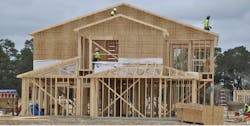Is the Labor Shortage About to Get Worse?
As home builders navigate social distancing guidelines at their construction sites, some are contemplating the potential impact of COVID-19 on the longer-term availability of skilled labor.
As for the pandemic’s immediate consequences, 77% of builders indicated that the waning willingness of workers and subcontractors to report to the jobsite was having on adverse effect on their business, according to a recent National Association of Home Builders survey. That trend, rising in all regions, was most pronounced in the Northeast, which has more coronavirus hot spots than other areas.
Absent From the Jobsite
In cases where subcontractors were no-shows, some builders reported that absences were the result of reasonable scenarios, such as a plumber who is a single dad and had to stay home with his children because schools and daycare centers were closed, or a drywaller who has a pregnant wife and is opting to shelter in place to reduce the risk of her contracting the virus. Those situations are temporary and construction still progresses, although more slowly, with workaround solutions.
Other builders report that trade partners that have or are considering laying off employees are concerned about being able to bring them back, particularly if those workers can make more money staying at home than they would make working, thanks to a provision in the Coronavirus Aid, Relief, and Economic Security (CARES) Act that provides unemployed workers with $600 per week on top of their state’s weekly unemployment compensation through the end of July.
“One thing you’re finding is that people who make less than $900 a week are begging to get fired, and that could create a problem,” says Blaine Flynn, CEO and president of FlynnBuilt, in Pensacola, Fla., and president of the Home Builders Association of West Florida. “I don’t think we’re affected as much as people who work in hospitality because that industry pays less than what construction pays, but $900 [in stimulus dollars] can go a long way in some of the Florida counties we build in.”
RELATED
- Advice and Preliminary Policy From a Midsize Builder During the Pandemic
- 5 Initiatives to Address the Labor Shortage Now
- Close Relations: Ways Builders Can Work Well With Trades
- Paycheck Protection Program: Builders Uncertain But Hopeful Pursuing Coronavirus Relief Loans
Not the First Time for Layoffs
But perhaps a more formidable competitor for maintaining the ranks of skilled labor could be layoff fatigue. Between the Great Recession and the current public health crisis, many tradespeople are enduring their second or third bout of being jobless.
“In the last previous downturn, there were a lot of people who left the crafts, and we don’t want to lose any more of our skilled labor workforce through this thing, however many weeks [the pandemic and its associated restrictions] last,” says Mike Schaap, founder and president of Mike Schaap Builders, in Holland, Mich. “We want [skilled trades] to sustain themselves, so they don’t say ‘screw this’ because they get furloughed every time there’s a downturn. We want to make sure we come out on the other side of this with a strong workforce. That’s been an ongoing battle.”
So far, that skilled labor exodus hasn’t happened, but Ryan Clarke, director of operations for Robuck Homes, in Raleigh, N.C., has been talking about that possibility with his trade council. “Subcontractors are worried that the young labor they get is not good and there’s not a lot of them,” Clarke says. “If the average age of tradesmen is 50, and this is the second or third time they’ve gone through a downturn, they may say, ‘You know what, I’m done with this,’ and that's where you see the grocery-store effect.”
So far, the skilled labor exodus hasn’t happened, but Ryan Clarke, director of operations for Robuck Homes, has been talking about that possibility with his trade council.
He’s referring to the large grocery store chains that have opened in his market, such as a Wegmans, which opened a Raleigh store last September and in nearby West Cary in August. Wegmans claims its starting hourly pay is equal to or greater than its supermarket competitors, and the company bumped up hourly wages for all employees by $2 during March and April. The grocer also offers benefits, including disability paid sick leave for part-time and full-time employees without the need for medical documentation.
“[Those grocery store employees are] in air conditioned space working for a huge corporation that can pay pretty good benefits,” Clarke says. “That's at least better than what employees at a small plumbing contractor with 20 employees are getting. Workers may just say 'I’m going to work here. I’ll make a little bit less, but I’m on the way to retirement, so what’s it matter?' It’s conjecture, but it’s enough of a concern that people are talking about it.”
Possible Silver Lining
If there is a silver lining to all of the hand-wringing, it may be that several framers have reached out to Clarke offering competitive pricing. The availability of framing carpenters has been tight during the recovery, particularly in Raleigh, as more national builders have planted their flags there. Now, as the nationals cut back on starts, framers are looking for work.
“This might just be my chance as a builder to get framers in the door in a tight labor market and show what it's like to work for us,” Clarke says. “We pay well and we pay every two weeks compared with net 30 or net 60 from some builders. Then I can win a quality partner from a national.”


